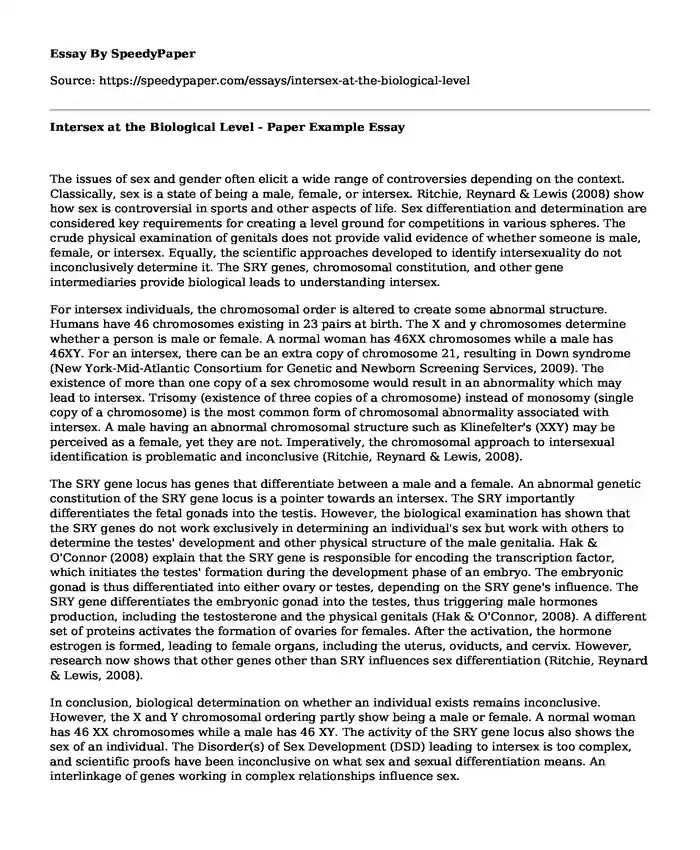The issues of sex and gender often elicit a wide range of controversies depending on the context. Classically, sex is a state of being a male, female, or intersex. Ritchie, Reynard & Lewis (2008) show how sex is controversial in sports and other aspects of life. Sex differentiation and determination are considered key requirements for creating a level ground for competitions in various spheres. The crude physical examination of genitals does not provide valid evidence of whether someone is male, female, or intersex. Equally, the scientific approaches developed to identify intersexuality do not inconclusively determine it. The SRY genes, chromosomal constitution, and other gene intermediaries provide biological leads to understanding intersex.
For intersex individuals, the chromosomal order is altered to create some abnormal structure. Humans have 46 chromosomes existing in 23 pairs at birth. The X and y chromosomes determine whether a person is male or female. A normal woman has 46XX chromosomes while a male has 46XY. For an intersex, there can be an extra copy of chromosome 21, resulting in Down syndrome (New York-Mid-Atlantic Consortium for Genetic and Newborn Screening Services, 2009). The existence of more than one copy of a sex chromosome would result in an abnormality which may lead to intersex. Trisomy (existence of three copies of a chromosome) instead of monosomy (single copy of a chromosome) is the most common form of chromosomal abnormality associated with intersex. A male having an abnormal chromosomal structure such as Klinefelter's (XXY) may be perceived as a female, yet they are not. Imperatively, the chromosomal approach to intersexual identification is problematic and inconclusive (Ritchie, Reynard & Lewis, 2008).
The SRY gene locus has genes that differentiate between a male and a female. An abnormal genetic constitution of the SRY gene locus is a pointer towards an intersex. The SRY importantly differentiates the fetal gonads into the testis. However, the biological examination has shown that the SRY genes do not work exclusively in determining an individual's sex but work with others to determine the testes' development and other physical structure of the male genitalia. Hak & O'Connor (2008) explain that the SRY gene is responsible for encoding the transcription factor, which initiates the testes' formation during the development phase of an embryo. The embryonic gonad is thus differentiated into either ovary or testes, depending on the SRY gene's influence. The SRY gene differentiates the embryonic gonad into the testes, thus triggering male hormones production, including the testosterone and the physical genitals (Hak & O'Connor, 2008). A different set of proteins activates the formation of ovaries for females. After the activation, the hormone estrogen is formed, leading to female organs, including the uterus, oviducts, and cervix. However, research now shows that other genes other than SRY influences sex differentiation (Ritchie, Reynard & Lewis, 2008).
In conclusion, biological determination on whether an individual exists remains inconclusive. However, the X and Y chromosomal ordering partly show being a male or female. A normal woman has 46 XX chromosomes while a male has 46 XY. The activity of the SRY gene locus also shows the sex of an individual. The Disorder(s) of Sex Development (DSD) leading to intersex is too complex, and scientific proofs have been inconclusive on what sex and sexual differentiation means. An interlinkage of genes working in complex relationships influence sex.
References
Hake, L., & O'Connor, C. (2008). Genetic mechanisms of sex determination. Nature Education, 1(1), 25.
New York-Mid-Atlantic Consortium for Genetic and Newborn Screening Services(2009). Understanding genetics: a New York, Mid-Atlantic guide for patients andhealth professionals. Lulu. com.
Ritchie, R., Reynard, J., & Lewis, T. (2008). Intersex and the Olympic games. Journal of the Royal Society of Medicine, 101(8), 395-399. https://doi.org/10.1258/jrsm.2008.080086.
Cite this page
Intersex at the Biological Level - Paper Example. (2023, Dec 29). Retrieved from https://speedypaper.com/essays/intersex-at-the-biological-level
Request Removal
If you are the original author of this essay and no longer wish to have it published on the SpeedyPaper website, please click below to request its removal:
- Politeness Orientation in the Linguistic Expression of Gratitude in America and Indonesia: Generation X and Y
- Free Essay about Workplace Alert System: Speaker Announcements
- Free Essay: Why Is the Idea of Liberal Media Bias so Widespread?
- Essay Sample on Culture or Climate in the WorkPlace
- Free Essay. Electronic Health Records-Business Intelligence
- Essay Sample on Employee Assistance Programs
- Paper Example: Relationship between Project Manager and the Systems Engineer
Popular categories





